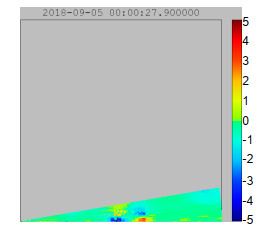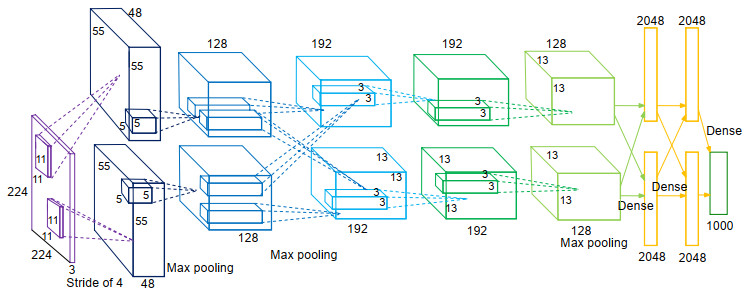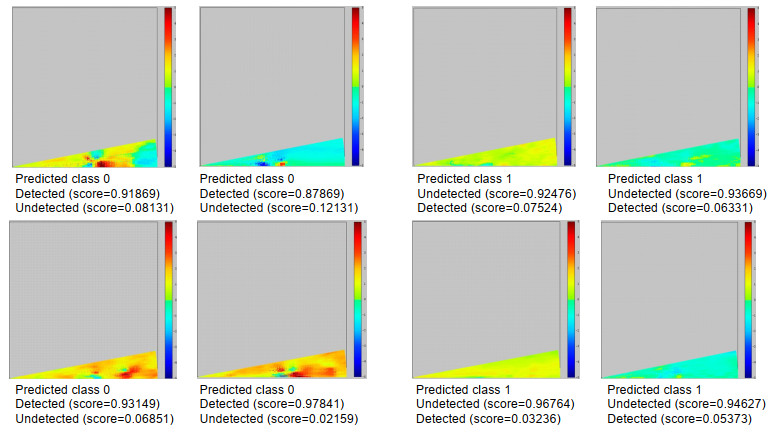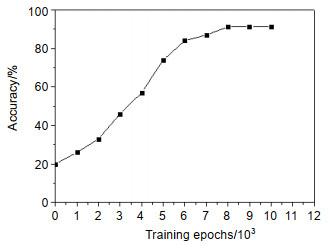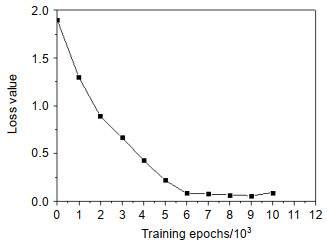-
摘要
为解决飞机尾涡威胁后机飞行安全问题,保障空中交通安全,提高机场和空域容量,提出了一种基于AlexNet卷积神经网络模型的算法,实现飞机尾涡的准确识别。结合多普勒激光雷达探测原理和Hallck-Burnham尾涡速度经典模型,构建了AlexNet神经网络模型提取大气风场中的尾涡速度云图的图像特征,识别飞机尾涡。研究表明,该模型能够准确识别目标空域中的飞机尾涡,网络模型收敛后对尾涡识别的准确率高达91.30%,并具有低虚警率,能有效地实现对飞机尾涡的识别和预警,达到尾涡监测的目的。

-
关键词:
- 尾涡识别 /
- AlexNet卷积神经网络 /
- 目标识别 /
- 多普勒激光雷达
Abstract
In order to solve the flight safety issues threatened by wake vortex of leading aircraft, ensure air traffic safety, and improve the capacity of airdrome and airspace, an AlexNet convolutional neural network model algorithm is proposed to identify aircraft wake vortex. Combined with the detection principle of Doppler LiDAR and the classic model of Hallck-Burnham wake vortex velocity, the AlexNet neural network model was constructed to extract the image features of the wake vortex velocity images in the atmosphere and identify the aircraft wake vortex. The research shows that the model is able to accurately identify the aircraft wake vortex in the target airspace. After the network model converges, the accuracy rate reaches to 91.30%, which can effectively realize the identification work. Meanwhile, this study also demonstrates the low probability of false alarm of the AlexNet neural network in detecting wake vortex, which meets the requirement of early warning and monitoring of the aircraft wake vortex.
-
Overview
Overview: Wake vortices develop as a consequence of the lift an aircraft produced to fly. For a wing generating lift, the pressure on the wing lower surface is higher than the pressure on the wing upper face. Therefore, air flows around the wing tip from the lower surface to the upper surface resulting in a strong vortex, the so-called "wing tip vortex". An airplane affected by a wake vortex experience may cause rolling moment even air crash. Given that, how to recognize wake vortex and monitor it to improve the capacity of airdrome and airspace, has become a key issue in civil aviation industry. The traditional method of detecting wake vortex generally adopts Doppler LiDAR, which is considered one of the most effective approach. In this paper, the LiDAR made use of the range-height-indication mode to obtain the radial velocity of the wake vortex, and the tangential velocity was calculated by the Hallock-Burnham vortex model, and then converted the velocity data to the speed maps of the vortex through processing. With the rapid development of artificial intelligence, convolution neural networks has turned out to be a powerful tool to deal with image analysis. For this reason, this paper applied AlexNet neural network model combined with the detection principle of Doppler LiDAR to extract the image features of the wake vortex velocity images in the atmosphere and identified the aircraft wake vortex by training a large amount of vortex maps. Aiming at perfecting the data sets, this experiment collected the flight departure data within 40 days of an airport in China. The airport took off about 500 flights a day, including A340, A380 and ARJ21 and so on. The AlexNet was trained and tested on the designed data sets, which involved 4000 training sets and 1000 validation sets and the training epochs were set as 10000. The qualitative experiment results show that after the network model converges, the accuracy rate reaches to 91.30%, which can effectively realize the identification work, monitoring of the aircraft wake vortex, as well as early warning. This research demonstrates the high accuracy and low probability of false alarm of the AlexNet neural network in detecting wake vortex and is capable to provide decision-making information for air traffic control work.

-

-
表 1 AlexNet参数设置
Table 1. AlexNet parameter settings
Name Type Filter size Stride Padding Output size Input data Color image — — — 224×224×3 Conv1 — 7×7 4 0 55×55×96 Pool1 Max pooling 3×3 2 0 27×27×96 Conv2 — 5×5 1 2 27×27×256 Pool2 Max pooling 3×3 2 0 13×13×256 Conv3 — 3×3 1 1 13×13×384 Conv4 — 3×3 1 1 13×13×384 Conv5 — 3×3 1 1 13×13×384 Pool5 Max pooling 3×3 2 0 6×6×256 Fc6 — — — — 4049 Fc7 — — — — 4049 Fc8 — — — — 1000 Softmax with loss 表 2 1.5 μm脉冲相干多普勒激光雷达的系统参量
Table 2. System parameters of 1.5 μm pulse coherent Doppler LiDAR
Name Value Observation mode RHI Detection range/m 45~915 Detection accuracy/m 30 Scan angel range/(°) 10~60 Scan step length/(°) 1 -
参考文献
[1] Hallock J N, Holzäpfel F.A review of recent wake vortex research for increasing airport capacity[J].Progress in Aerospace Sciences, 2018, 98:27-36. doi: 10.1016/j.paerosci.2018.03.003
[2] Gerz T, Holzäpfel F, Darracq D.Commercial aircraft wake vortices[J].Progress in Aerospace Sciences, 2002, 38(3):181-208. doi: 10.1016/S0376-0421(02)00004-0
[3] Frehlich R, Sharman R.Maximum likelihood estimates of vortex parameters from simulated coherent Doppler Lidar data[J].Journal of Atmospheric and Oceanic Technology, 2005, 22(2):117-130. doi: 10.1175/JTECH-1695.1
[4] Choroba P.Comprehensive study of the wake vortex phenomena to the assessment of its incorporation to ATM for safety and capacity improvements[D].Slovakia: The University of Zilina, 2006.
[5] 魏志强.尾涡流场及安全间隔的建模与仿真计算研究[D].天津: 中国民航大学, 2008.
Wei Z Q.The Research on modeling and simulation on flow field and safety spacing for wake vortex[D].Tianjin: Civil Aviation University of China, 2008.
[6] K pp F, Rahm S, Smalikho I.Characterization of aircraft wake vortices by 2-μm pulsed Doppler lidar[J].Journal of Atmospheric and Oceanic Technology, 2004, 21(2):194-206. doi: 10.1175/1520-0426(2004)021<0194:COAWVB>2.0.CO;2
[7] Holzäpfel F, Gerz T, K pp F, et al.Strategies for circulation evaluation of aircraft wake vortices measured by lidar[J].Journal of Atmospheric and Oceanic Technology, 2003, 20(8):1183-1195. doi: 10.1175/1520-0426(2003)020<1183:SFCEOA>2.0.CO;2
[8] Barbaresco F, Jeantet A, Meier U.Wake vortex detection & monitoring by X-band doppler radar: paris orly radar campaign results[C]//Proceedings of 2007 IET International Conference on Radar Systems, Edinburgh, UK, 2007.
[9] Barbaresco F, Meier U.Radar monitoring of a wake vortex:electromagnetic reflection of wake turbulence in clear air[J].Comptes Rendus Physique, 2010, 11(9):54-67. http://cn.bing.com/academic/profile?id=ff86b1fd1abf331143dfe26c45bae761&encoded=0&v=paper_preview&mkt=zh-cn
[10] Profeta A, Rodriguez A, Clouse H S.Convolutional neural networks for synthetic aperture radar classification[J].Proceedings of SPIE, 2006, 9843:98430M. http://cn.bing.com/academic/profile?id=ba24594769e24a8cc213c8a7afa22c3e&encoded=0&v=paper_preview&mkt=zh-cn
[11] 吴永华, 胡以华, 戴定川, 等.基于1.5μm多普勒激光雷达的飞机尾涡探测技术研究[J].光子学报, 2011, 40(6):811-817. http://d.old.wanfangdata.com.cn/Periodical/gzxb201106002
Wu Y H, Hu Y H, Dai D C, et al.Research on the technique of aircraft wake vortex detection based on 1.5μm doppler lidar[J].Acta Photonica Sinica, 2011, 40(6):811-817. http://d.old.wanfangdata.com.cn/Periodical/gzxb201106002
[12] 李策, 刘俊伟, 赵培娥, 等.机动型激光测风雷达倾斜风场修正算法研究[J].激光技术, 2017, 41(3):385-390. http://d.old.wanfangdata.com.cn/Periodical/jgjs201703016
Li C, Liu J W, Zhao P E, et al.Correction method of tilt wind field of mobile wind lidar[J].Laser Technology, 2017, 41(3):385-390. http://d.old.wanfangdata.com.cn/Periodical/jgjs201703016
[13] Arel I, Rose D C, Karnowski T P.Deep machine learning-a new frontier in artificial intelligence research[Research Frontier][J].IEEE Computational Intelligence Magazine, 2010, 5(4):13-18. doi: 10.1109/MCI.2010.938364
[14] 袁秋壮, 魏松杰, 罗娜.基于深度学习神经网络的SAR星上目标识别系统研究[J].上海航天, 2017, 34(5):46-53. http://d.old.wanfangdata.com.cn/Periodical/shht201705007
Yuan Q Z, Wei S J, Luo N.Research on SAR satellite target recognition system based on deep learning neural network[J].Aerospace Shanghai, 2017, 34(5):46-53. http://d.old.wanfangdata.com.cn/Periodical/shht201705007
[15] 尹宝才, 王文通, 王立春.深度学习研究综述[J].北京工业大学学报, 2015, 41(1):48-59. http://d.old.wanfangdata.com.cn/Periodical/jsjyyyj201208002
Yin B C, Wang W T, Wang L C.Review of deep learning[J].Journal of Beijing University of Technology, 2015, 41(1):48-59. http://d.old.wanfangdata.com.cn/Periodical/jsjyyyj201208002
[16] Krizhevsky A, Sutskever I, Hinton G E.ImageNet classification with deep convolutional neural networks[C]//Proceedings of the 25th International Conference on Neural Information Processing Systems, South Lake Tahoe, USA: 2012: 1097-1105.
[17] 张少华.基于深度卷积神经网络的人脸基准点定位研究[D].武汉: 华中科技大学, 2016.
Zhang S H.Research on facial landmark localization based on deep convolutional neural network[D].Wuhan: Huazhong University of Science and Technology, 2016.
[18] 胡以华, 吴永华.飞机尾涡特性分析与激光探测技术研究[J].红外与激光工程, 2011, 40(6):1063-1069. doi: 10.3969/j.issn.1007-2276.2011.06.015
Hu Y H, Wu Y H.Study on the characteristic of aircraft wake vortex and lidar detection technique[J]. Infrared and Laser Engineering, 2011, 40(6):1063-1069. doi: 10.3969/j.issn.1007-2276.2011.06.015
[19] 段萌, 王功鹏, 牛常勇.基于卷积神经网络的小样本图像识别方法[J].计算机工程与设计, 2018, 39(1):224-229. http://d.old.wanfangdata.com.cn/Periodical/jsjgcysj201801039
Duan M, Wang G P, Niu C Y.Method of small sample size image recognition based on convolution neural network[J].Computer Engineering and Design, 2018, 39(1):224-229. http://d.old.wanfangdata.com.cn/Periodical/jsjgcysj201801039
[20] 戴伟聪, 金龙旭, 李国宁, 等.遥感图像中飞机的改进YOLOv3实时检测算法[J].光电工程, 2018, 45(12):180350. doi: 10.12086/oee.2018.180350
Dai W C, Jin L X, Li G N, et al.Real-time airplane detection algorithm in remote-sensing images based on improved YOLOv3[J].Opto-Electronic Engineering, 2018, 45(12):180350. doi: 10.12086/oee.2018.180350
[21] 潘卫军, 张庆宇, 张强, 等.多普勒激光雷达的飞机尾涡识别方法[J].激光技术, 2019, 43(2):233-237. http://d.old.wanfangdata.com.cn/Periodical/jgjs201902016
Pan W J, Zhang Q Y, Zhang Q, et al.Identification method of aircraft wake vortex based on doppler lidar[J].Laser Technology, 2019, 43(2):233-237. http://d.old.wanfangdata.com.cn/Periodical/jgjs201902016
-
访问统计


 E-mail Alert
E-mail Alert RSS
RSS
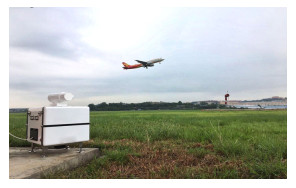
 下载:
下载:
